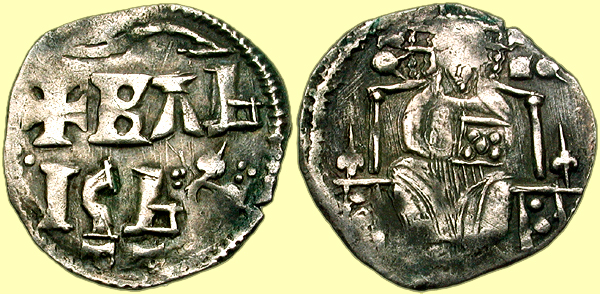|
VUK BRANKOVIC Vojvoda of Kosovo, 1371/5-1395/6 AR Dinar (0.67 g, 14mm, 7). |
||

|
Mint: Uncertain. Struck: Circa 1389-1395/6. Obv: +BΛЬ/KЬ ('VLK' in Serbian in two lines) Ivy vine (control symbol) to lower right, three groups of three pellets in fields, ornaments above and below. Rev: [no legend] Christ, nimbate, enthroned facing, holding Gospels; degraded IC XC flanking head. Ref: Jovanovic 33.18 var. (no pellets); Ivanisevic 31.8; Dimitrijevic 198.35. |
|
|
||
|
STEFAN LAZAREVIC As Knez of Pomoravlje, 1389-1402 AR Dinar (0.36 g, 13mm, 4). |
|

|
Mint: Uncertain. Struck: Uncertain. Obv: COnTE • S • TEFAn • Stefan standing facing, holding labarum; trefoil to right. Rev: +ICZVZ (quatrefoil) C[RIZT]VZ Facing nimbate head of Christ. Ref: Novakovic type 6; Jovanovic 41.7; Ivanisevic 42.6; Dimitrijevic Dimitrijevic 234 var. (legends). |
|
As Despot of Serbia, 1402-1427 AR Dinar (0.31 g, 13mm, 1). |
||

|
Mint: Uncertain. Struck: Uncertain. Obv: +ΔЄCΠOT CTЄΦA Cross pattée; pellet in each quarter. Rev: [no legend] Double-headed eagle; three pellets around. Ref: Novakovic type 1; Jovanovic 41.24; Ivanisevic 42.17; Dimitrijevic -. |
|
|
||
|
ÐURAÐ BRANKOVIC Despot, 1427-1456 AR Dinar (0.97 g, 16mm, 6). |
||

|
Mint: Uncertain. Struck: Struck circa 1427-1435. Obv: +ΓNЬ ΔЄCΠOTЬ ΓЮPЬΓЬ Lion rampant left; star below. Rev: [no legend] Christ, nimbate, enthroned facing, raising hand in benediction and holding Gospels; IC +C (Cs retro) flanking head. Ref: Jovanovic 42.22; Ivanisevic 45.10; Dimitrijevic 300. |
|
|
||

